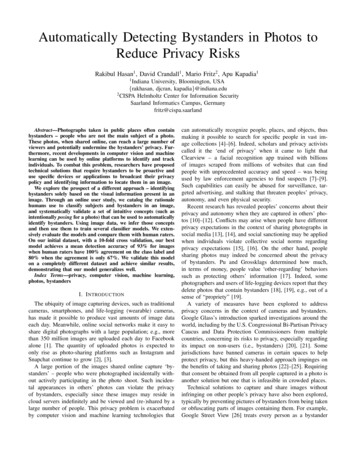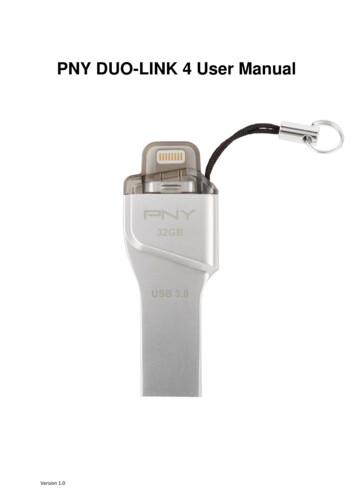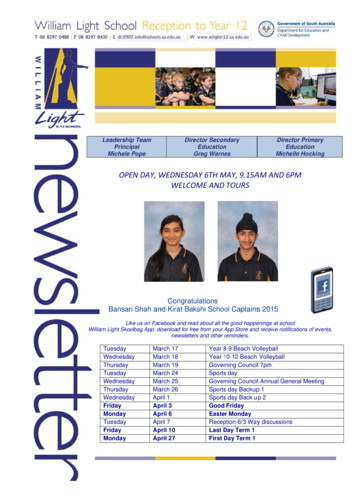
Transcription
Automatically Detecting Bystanders in Photos toReduce Privacy RisksRakibul Hasan1 , David Crandall1 , Mario Fritz2 , Apu Kapadia11Indiana University, Bloomington, USA{rakhasan, djcran, kapadia}@indiana.edu2CISPA Helmholtz Center for Information SecuritySaarland Informatics Campus, Germanyfritz@cispa.saarlandAbstract—Photographs taken in public places often containbystanders – people who are not the main subject of a photo.These photos, when shared online, can reach a large number ofviewers and potentially undermine the bystanders’ privacy. Furthermore, recent developments in computer vision and machinelearning can be used by online platforms to identify and trackindividuals. To combat this problem, researchers have proposedtechnical solutions that require bystanders to be proactive anduse specific devices or applications to broadcast their privacypolicy and identifying information to locate them in an image.We explore the prospect of a different approach – identifyingbystanders solely based on the visual information present in animage. Through an online user study, we catalog the rationalehumans use to classify subjects and bystanders in an image,and systematically validate a set of intuitive concepts (such asintentionally posing for a photo) that can be used to automaticallyidentify bystanders. Using image data, we infer those conceptsand then use them to train several classifier models. We extensively evaluate the models and compare them with human raters.On our initial dataset, with a 10-fold cross validation, our bestmodel achieves a mean detection accuracy of 93% for imageswhen human raters have 100% agreement on the class label and80% when the agreement is only 67%. We validate this modelon a completely different dataset and achieve similar results,demonstrating that our model generalizes well.Index Terms—privacy, computer vision, machine learning,photos, bystandersI. I NTRODUCTIONThe ubiquity of image capturing devices, such as traditionalcameras, smartphones, and life-logging (wearable) cameras,has made it possible to produce vast amounts of image dataeach day. Meanwhile, online social networks make it easy toshare digital photographs with a large population; e.g., morethan 350 million images are uploaded each day to Facebookalone [1]. The quantity of uploaded photos is expected toonly rise as photo-sharing platforms such as Instagram andSnapchat continue to grow [2], [3].A large portion of the images shared online capture ‘bystanders’ – people who were photographed incidentally without actively participating in the photo shoot. Such incidental appearances in others’ photos can violate the privacyof bystanders, especially since these images may reside incloud servers indefinitely and be viewed and (re-)shared by alarge number of people. This privacy problem is exacerbatedby computer vision and machine learning technologies thatcan automatically recognize people, places, and objects, thusmaking it possible to search for specific people in vast image collections [4]–[6]. Indeed, scholars and privacy activistscalled it the ‘end of privacy’ when it came to light thatClearview – a facial recognition app trained with billionsof images scraped from millions of websites that can findpeople with unprecedented accuracy and speed – was beingused by law enforcement agencies to find suspects [7]–[9].Such capabilities can easily be abused for surveillance, targeted advertising, and stalking that threaten peoples’ privacy,autonomy, and even physical security.Recent research has revealed peoples’ concerns about theirprivacy and autonomy when they are captured in others’ photos [10]–[12]. Conflicts may arise when people have differentprivacy expectations in the context of sharing photographs insocial media [13], [14], and social sanctioning may be appliedwhen individuals violate collective social norms regardingprivacy expectations [15], [16]. On the other hand, peoplesharing photos may indeed be concerned about the privacyof bystanders. Pu and Grossklags determined how much,in terms of money, people value ‘other-regarding’ behaviorssuch as protecting others’ information [17]. Indeed, somephotographers and users of life-logging devices report that theydelete photos that contain bystanders [18], [19], e.g., out of asense of “propriety” [19].A variety of measures have been explored to addressprivacy concerns in the context of cameras and bystanders.Google Glass’s introduction sparked investigations around theworld, including by the U.S. Congressional Bi-Partisan PrivacyCaucus and Data Protection Commissioners from multiplecountries, concerning its risks to privacy, especially regardingits impact on non-users (i.e., bystanders) [20], [21]. Somejurisdictions have banned cameras in certain spaces to helpprotect privacy, but this heavy-handed approach impinges onthe benefits of taking and sharing photos [22]–[25]. Requiringthat consent be obtained from all people captured in a photo isanother solution but one that is infeasible in crowded places.Technical solutions to capture and share images withoutinfringing on other people’s privacy have also been explored,typically by preventing pictures of bystanders from being takenor obfuscating parts of images containing them. For example,Google Street View [26] treats every person as a bystander
and blurs their face, but this aggressive approach is notappropriate for consumer photographs since it would destroythe aesthetic and utility value of the photo [27], [28]. Moresophisticated techniques selectively obscure people based ontheir privacy preferences [29]–[33], which are detected bynearby photo-taking devices (e.g., with a smartphone app thatbroadcasts preference using Bluetooth). Unfortunately, thisapproach requires the bystanders – the victims of privacyviolations – to be proactive in keeping their visual data private.Some proposed solutions require making privacy preferencespublic (e.g., using visual markers [34] or hand gestures [33])and visible to everyone, which in itself might be a privacyviolation. Finally, these tools are aimed at preventing privacyviolations as they happen and cannot handle the billions ofimages already stored in devices or the cloud.We explore a complementary technical approach: automatically detecting bystanders in images using computer vision.Our approach has the potential to enforce a privacy-by-defaultpolicy in which bystanders’ privacy can be protected (e.g., byobscuring them) without requiring bystanders to be proactiveand without obfuscating the people who were meant to playan important role in the photo (i.e., the subjects). It canalso be applied to images that have already been taken. Ofcourse, detecting bystanders using visual features alone ischallenging because the difference between a subject and abystander is often subtle and subjective, depending on theinteractions among people appearing in a photo as well as thecontext and the environment in which the photo was taken.Even defining the concepts of ‘subject’ and ‘bystander’ ischallenging, and we could not find any precise definition inthe context of photography; the Merriam-Webster dictionarydefines ‘bystander’ in only a general sense as “one who ispresent but not taking part in a situation or event: a chancespectator,” leaving much open to context as well as social andcultural norms.We approach this challenging problem by first conductinga user study to understand how people distinguish betweensubjects and bystanders in images. We found that humanslabel a person as ‘subject’ or ‘bystander’ based on socialnorms, prior experience, and context, in addition to the visualinformation available in the image (e.g., a person is a ‘subject’because they were interacting with other subjects). To moveforward in solving the problem of automatically classifyingsubjects and bystanders, we propose a set of high-level visualcharacteristics of people in images (e.g., willingness to bephotographed) that intuitively appear to be relevant for theclassification task and can be inferred from features extractedfrom images (e.g., facial expression [35]). Analyzing thedata from this study, we provide empirical evidence thatthese visual characteristics are indeed associated with therationale people utilize in distinguishing between subjectsand bystanders. Interestingly, exploratory factor analysis onthis data revealed two underlying social constructs used indistinguishing bystanders from subjects, which we interpretas ‘visual appearance’ and ‘prominence’ of the person in aphoto.We then experimented with two different approaches forclassifying bystanders and subjects. In the first approach, wetrained classifiers with various features extracted from imagedata, such as body orientation [36] and facial expression [35].In the second approach, we used the aforementioned featuresto first predict the high-level, intuitive visual characteristicsand then trained a classifier on these estimated features. Theaverage classification accuracy obtained from the first approach was 76%, whereas the second approach, based on highlevel intuitive characteristics, yielded an accuracy of 85%.This improvement suggests that the high-level characteristicsmay contain information more pertinent to the classificationof ‘subject’ and ‘bystander’, and with less noise comparedto the lower-level features from which they were derived.These results justify our selection of these intuitive features,but more importantly, it yields an intuitively-explainable andentirely automatic classifier model where the parameters canbe reasoned about in relation to the social constructs humansuse to distinguish bystanders from subjects.II. R ELATED WORKPrior work on alleviating privacy risks of bystanders canbe broadly divided into two categories – techniques to handleimages i) stored in the photo-capturing device and ii) afterbeing uploaded to the cloud (Perez et al. provide a taxonomyof proposed solutions to protect bystanders’ privacy [37]).A. Privacy protection in the moment of photo capture1) Preventing image capture: Various methods have beenproposed to prevent capturing photographs to protect the privacy of nearby people. One such method is to temporarily disable photo-capturing devices using specific commands whichare communicated by fixed devices (such as access points)using Bluetooth and/or infrared light-based protocols [38]. Onelimitation of this method is the photographers would have tohave compliant devices. To overcome this limitation, Truong etal. proposed a ‘capture resistant environment’ [39] consistingof two components: a camera detector that locates cameralenses with charged coupled devices (CCD) and a cameraneutralizer that directs a localized beam of light to obstructits view of the scene. This solution is, however, effective onlyfor cameras using CCD sensors. A common drawback sharedby these location-based techniques [38], [39] is that it mightbe infeasible to install them in every location.Aditya et al. proposed I-Pic [29], a privacy enhancedsoftware platform where people can specify their privacypolicies regarding photo-taking (i.e., allowed or not to takephoto), and compliant cameras can apply these policies overencrypted image features. Although this approach needs theactive participation of bystanders, Steil et al. proposed PrivacEye [40], a prototype system to automatically detect andprevent capturing images of people by automatically coveringthe camera with a shutter. Although there is no action neededfrom the bystanders to protect their privacy, PrivacEye [40]considers every person appearing in an image, limiting itsapplicability in more general settings of photography.2
The main drawback with these approaches is that they seekto completely prevent the capture of the image. In many cases,this may be a heavy-handed approach where removing orobscuring bystanders is more desirable.2) Obscuring bystanders: Several works utilize imageobfuscation techniques to obscure bystanders images, insteadof preventing image capture in the first place. Farinella etal. developed FacePET [41] to protect facial-privacy by distorting the region of an image containing a face. It makesuse of glasses to emit light patterns designed to distort theHaar-like features used in some face detection algorithms.Such systems, however, will not be effective for other facedetection algorithms such as deep learning-based approaches.COIN [30] lets users broadcast privacy policies and identifyinginformation in much the same way as I-Pic [29] and obscureidentified bystanders. In the context of wearable devices,Dimiccoli et al. developed deep-learning based algorithms torecognize activities of people in egocentric images degradedin quality to protect the privacy of the bystanders [42].Another set of proposed solutions enable people to specifyprivacy preferences in situ. Li et al. present PrivacyCamera [43], a mobile application that handles photos containingat most two people (either one bystander, or one targetand one bystander). Upon detecting a face, the app sendsnotifications to nearby bystanders who are registered usersof the application using short-range wireless communication.The bystanders respond with their GPS coordinates, and theapp then decides if a given bystander is in the photo basedon the position and orientation of the camera. Once thebystander is identified (e.g., the smaller of the two faces),their face is blurred. Ra et al. proposed Do Not Capture(DNC) [31], which tries to protect bystanders’ privacy in moregeneral situations. Bystanders broadcast their facial featuresusing a short-range radio interface. When a photo is taken,the application computes motion trajectories of the people inthe photo, and this information is then combined with facialfeatures to identify bystanders, whose faces are then blurred.Several other papers allow users to specify default privacypolicies that can be updated based on context using gesturesor visual markers. Using Cardea [32], users can state defaultprivacy preferences depending on location, time, and presenceof other users. These static policies can be updated dynamically using hand gestures, giving users flexibility to tune theirpreferences depending on the context. In a later work, Shu etal. proposed an interactive visual privacy system that uses tagsinstead of facial features to obtain the privacy preferences of agiven user [33]. This is an improvement over Cardea’s systemsince facial features are no longer required to be uploaded.Instead, different graphical tags (such as a logo or a template,printed or stuck on clothes) are used to broadcast privacypreferences, where each of the privacy tags refer to a specificprivacy policy, such as ‘blur my face’ or ‘remove my body’.In addition to the unique limitations of each of theaforementioned techniques, they also share several commondrawbacks. For example, solutions that require transmittingbystanders’ identifying features and/or privacy policies overwireless connections are prone to Denial of Service attacksif an adversary broadcasts this data at a high rate. Further,there might not enough time to exchange this informationwhen the bystander (or the photographer) is moving and goesoutside of the communication range. Location-based notification systems might have limited functionality in indoor spaces.Finally, requiring extra sensors, such as GPS for location andBluetooth for communication, may prevent some devices (suchas traditional cameras) from adopting them.B. Protecting bystanders’ privacy in images in the cloudAnother set of proposed solutions attempts to reduce privacyrisks of the bystanders after their photos have been uploadedto the cloud. Henne et al. proposed SnapMe [44], whichconsists of two modules: a client where users register, anda cloud-based watchdog which is implemented in the cloud(e.g., online social network servers). Registered users canmark locations as private, and any photo taken in such alocation (as inferred from image meta-data) triggers a warningto all registered users who marked it as private. Users canadditionally let the system track their locations and sendwarning messages when a photo is captured nearby theircurrent location. The users of this system have to make aprivacy trade-off, since increasing visual privacy will result ina reduction in location privacy.Bo et al. proposed a privacy-tag (a QR code) and anaccompanying privacy-preserving image sharing protocol [34]which could be implemented in photo sharing platforms. Thepreferences from the tag contain a policy stating whether ornot photos containing the wearer can be shared, and if so,with whom (i.e. in which domains/PSPs). If sharing is notpermitted, then the face of the privacy tag wearer is replacedby a random pattern generated using a public key from thetag. Users can control dissemination by selectively distributingtheir private keys to other people and/or systems to decrypt theobfuscated regions. More recently, Li and colleagues proposedHideMe [45], a plugin for social networking websites thatcan be used to specify privacy policies. It blurs people whoindicated in their policies that they do not want to appear inother peoples’ photos. The policies can be specified based onscenario instead of for each image.A major drawback of these cloud-based solutions is thatthe server can be overwhelmed by uploading a large numberof fake facial images or features. Even worse, an adversarycan use someone else’s portrait or facial features and specifyan undesirable privacy policy. Another limitation is that theydo not provide privacy protection for the images that wereuploaded in the past and still stored in the cloud.C. Effectively obscuring privacy-sensitive elements in a photoAfter detecting bystanders, most of the work describedabove obfuscate them using image filters (e.g., blurring [43])or encrypting regions of an image [46], [47]. Prior research hasdiscovered that not all of these filters can effectively obscurethe intended content [27]. Masking and scrambling regions ofinterest, while effective in protecting privacy, may result in3
a significant reduction of image utility such as ‘informationcontent’ and ‘visual aesthetics’ [27]. In the context of sharingimages online, privacy-protective mechanisms, in addition tobeing effective, are required to preserve enough utility to ensure their wide adoption. Thus, recent work on image privacyhas attempted to maximize both the effectiveness and utilityof obfuscation methods [28], [48]. Another line of researchfocuses solely on identifying and/or designing effective and“satisfying” (to the viewer) image filters to obfuscate privacysensitive attributes of people (e.g., identify, gender, and facialexpression) [27], [49]–[51]. Our work is complementary tothese efforts and can be used in combination with them tofirst automatically identify what to obscure and then use theappropriate obfuscation method.the photo shooting event and willingness to be a part of it.Moreover, we expect someone to look comfortable while beingphotographed if they are intentionally participating. Othervisual characteristics signal the importance of a person forthe semantics of the photo and whether they were captureddeliberately by the photographer. We hypothesize that humansinfer these characteristics from context and the environment,location and size of a person, and interactions among peoplein the photo. Finally, we are also interested to learn how thephoto’s environment (i.e., a public or a private space) affectpeoples’ perceptions of subjects and bystanders.To empirically test the validity of this set of high-levelconcepts and to identify a set of image features that are associated with these concepts that would be useful as predictorsfor automatic classification, we conducted a user study. Inthe study, we asked participants to label people in imagesas ‘bystanders’ or ‘subjects’ and to provide justification fortheir labels. Participants also answered questions relating tothe high-level concepts described above. In the followingsubsections, we describe the image set used in the study andthe survey questionnaire.III. S TUDY M ETHODWe begin with an attempt to define the notions of ‘bystander’ and ‘subject’ specific to the context of images.According to general dictionary definitions,1,2,3 a bystander isa person who is present and observing an event without takingpart in it. But we found these definitions to be insufficient tocover all the cases that can emerge in photo-taking situations.For example, sometimes a bystander may not even be aware ofbeing photographed and, hence, not observe the photo-takingevent. Other times, a person may be the subject of a photowithout actively participating (e.g., by posing) in the event oreven noticing being photographed, e.g., a performer on stagebeing photographed by the audience. Hence, our definitions of‘subject’ and ‘bystander’ are centered around how importanta person in a photo is and the intention of the photographer.Below, we provide the definitions we used in our study.A. Survey design1) Image set: We used images from the Google openimage dataset [52], which has nearly 9.2 million images ofpeople and other objects taken in unconstrained environments.This image dataset has annotated bounding boxes for objectsand object parts along with associated class labels for objectcategories (such as ‘person’, ‘human head’, and ‘door handle’).Using these class labels, we identified a set of 91,118 imagesthat contain one to five people. Images in the Google datasetwere collected from Flickr without using any predefined list ofclass names or tags [52]. Accordingly, we expect this datasetto reflect natural class statistics about the number of peopleper photo. Hence, we attempted to keep the distribution ofimages containing a specific number of people the same as inthe original dataset. To use in our study, we randomly sampled1,307, 615, 318, 206, and 137 images containing one to fivepeople, respectively, totaling to 2,583 images. A ‘stimulus’ inour study is comprised of an image region containing a singleperson. Hence, an image with one person contributed to onestimulus, an image with two people contributed to two stimuli,and so on, resulting in a total of 5,000 stimuli. If there are Nstimuli in an image, we made N copies of it and each copy waspre-processed to draw a rectangular bounding box enclosingone of the N stimuli as shown in Fig. 1. This resulted in 5,000images corresponding to the 5,000 stimuli. From now on, weuse the terms ‘image’ and ‘stimulus’ interchangeably.2) Measurements: In the survey, we asked participants toclassify each person in each image as either a ‘subject’ or‘bystander,’ as well as to provide reasons for their choice.In addition to these, we asked to rate each person accordingto the ‘high-level concepts’ described above. Details of thesurvey questions are provided below, where questions 2 to 8are related to the high-level concepts.Subject: A subject of a photo is a person who is importantfor the meaning of the photo, e.g., the person was capturedintentionally by the photographer.Bystander: A bystander is a person who is not a subjectof the photo and is thus not important for the meaning ofthe photo, e.g., the person was captured in a photo onlybecause they were in the field of view and was not intentionallycaptured by the photographer.The task of the bystander detector (as an ‘observer’ of aphoto) is then to infer the importance of a person for themeaning of the photo and the intention of the photographer.But unlike human observers, who can make use of pastexperience, the detector is constrained to use only the visualdata from the photo. Consequently, we turned to identifyinga set of visual characteristics or high-level concepts that canbe directly extracted or inferred from visual features and areassociated with human rationales and decision criteria.A central concept in the definition of bystander is whethera person is actively participating in an event. Hence, we lookfor the visual characteristics indicating intentional posing fora photo. Other related concepts to this are being aware of1 er2 lish/bystander3 https://www.urbandictionary.com/define.php?term bystander4
(a) Image with a single person.(b) Image with five people where the(c) An image where the annotated areastimulus is enclosed by a bounding box. contains a sculpture.Fig. 1. Example stimuli used in our survey.1) Which of the following statements is true for theperson inside the green rectangle in the photo? withanswer options i) There is a person with some of themajor body parts visible (such as face, head, torso);ii) There is a person but with no major body part visible(e.g., only hands or feet are visible); iii) There is just adepiction/representation of a person but not a real person(e.g., a poster/photo/sculpture of a person); iv) Thereis something else inside the box; and v) I don’t seeany box. This question helps to detect images that wereannotated with a ‘person’ label in the original Googleimage dataset [52] but, in fact, contain some form ofdepiction of a person, such as a portrait or a sculpture(see Fig. 1). The following questions were asked only ifone of the first two options was selected.2) How would you define the place where the photo wastaken? with answer options i) A public place; ii) A semipublic place; iii) A semi-private place; iv) A private place;and v) Not sure.3) How strongly do you disagree or agree with the following statement: The person inside the green rectanglewas aware that s/he was being photographed? witha 7-point Likert item ranging from strongly disagree tostrongly agree.4) How strongly do you disagree or agree with thefollowing statement: The person inside the greenrectangle was actively posing for the photo. with a7-point Likert item ranging from strongly disagree tostrongly agree.5) In your opinion, how comfortable was the person withbeing photographed? with a 7-point Likert item rangingfrom highly uncomfortable to highly comfortable.6) In your opinion, to what extent was the person inthe green rectangle unwilling or willing to be inthe photo? with a 5-point Likert item ranging fromcompletely unwilling to completely willing.7) How strongly do you agree or disagree with thestatement: The photographer deliberately intended tocapture the person in the green box in this photo? witha 7-point Likert item ranging from strongly disagree tostrongly agree.8) How strongly do you disagree or agree with thefollowing statement: The person in the green boxcan be replaced by another random person (similarlooking) without changing the purpose of this photo.with a 7-point Likert item ranging from strongly disagreeto strongly agree. Intuitively, this question asks to rate the‘importance’ of a person for the semantic meaning of theimage. If a person can be replaced without altering themeaning of the image, then s/he has less importance.9) Do you think the person in the green box is a‘subject’ or a ‘bystander’ in this photo? with answeroptions i) Definitely a bystander; ii) Most probably abystander; iii) Not sure; iv) Most probably a subject; andv) Definitely a subject. This question was accompaniedby our definitions of ‘subject’ and ‘bystander’.10) Depending on the response to the previous question, weasked one of the following three questions: i) Why doyou think the person in the green box is a subjectin this photo? ii) Why do you think the person inthe green box is a bystander in this photo? iii) Pleasedescribe why do you think it is hard to decide whetherthe person in the green box is a bystander or a subjectin this photo? Each of these questions could be answeredby selecting one or more options that were provided. Wecurated these options from a previously conducted pilotstudy where participants answered this question with freeform text responses. The most frequent responses in eachcase were then provided as options for the main surveyalong with a text box to provide additional input in casethe provided options were not sufficient.3) Survey implementation: The 5,000 stimuli selected foruse in the experiment were ordered and then divided into setsof 50 images, resulting in 100 image sets. This was donesuch that each set contained a proportionally equal number ofstimuli of images containing one to five people. Each surveyparticipant was randomly presented with one of the sets, andeach set was presented to at least three participants. The surveywas implemented in Qualtrics [53] and advertised on AmazonMechanical Turk (MTurk) [54]. It was restricted to MTurkworkers who spoke English, had been living in the USA forat least five years (to help control for cultural variability [55]),and were at least 18 years old. We further required that workershave a high reputation (above a 95% approval rating on at least5
1,000 completed HITs) to ensure data quality [56]. Finally,we used two attention-check questions to filter out inattentiveresponses [57] (see Appendix F).4) Survey flow: The user study flowed as follows:1. Consent form with details of the experiment, expectedtime to finish, and compensation.2. Instructions on how to respond to the survey questionswith a sample image and appropriate responses to thequestions.3. Questions related to the images as described in Section III-A2 for fifty images.4. Questions on social media usage and demographics.‘neither’ label. In this final set of images, we have 2,287(60.15%) ‘subjects’ and 1,515 (39.85%) ‘bystanders’.3) Feature set: As described in section III-A2, we askedsurvey participants to rate each image for several ‘high-levelconcepts’ (questions 2–8). The responses were converted intonumerical values – the ‘neutral’ options (such as ‘neitherdisagree nor agree’) were assigned a zero score, the leftmost options (such as ‘strongly disagree’) were assigned theminimum score (-3 for a 7-point
by these location-based techniques [38], [39] is that it might be infeasible to install them in every location. Aditya et al. proposed I-Pic [29], a privacy enhanced software platform where people can specify their privacy policies regarding photo-taking (i.e., allowed or not to take photo), and compliant cameras can apply these policies over










